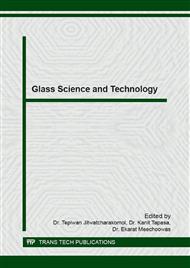p.23
p.28
p.32
p.37
p.43
p.51
p.57
p.62
p.66
Shift of Glass Transition Temperature under High Pressure for Ge20Te80 Glass
Abstract:
Amorphous solids prepared from their melt state exhibit glass transition phenomena upon heating. Derivatives of volume like viscosity, specific heat and thermal expansion coefficient show rapid changes at the glass transition temperature (Tg). In general, application f high pressure increases the Tg (a positive dTg/dP). This positive dTg/dP has been well understood with the Free Volume and Entropy models. However, there are few exceptions where a negative dTg/dP has been observed. It has been proposed that the glasses which undergo negative thermal expansion can exhibit a negative dTg/dP. In this study, electrical resistivity of semiconducting Ge20Te80 glass at high pressures as a function of temperature has been measured in a Bridgman anvil apparatus. Electrical resistivity showed a pronounced change at Tg. The pressure dependence of Tg (dTg/dP) shows a decreasing trend (-dTg/dP). Chalcogenide glasses like Se, As2Se3 and As30Se30Te40 show a positive dTg/dP in contradiction to the present observation of negative dTg/dP. A model proposed by deNeufville and Rockstad finds a linear relationship between Tg and the optical band gap (Eg) when they are grouped according to their connectivity (Zav).Application of high pressure decreases the interatomic distance which in turn decreases the separation between the valence and conduction bands (optical band gap). This reduction in optical band gap shifts the glass transition to lower values. It is also suggested that the sign of the pressure derivative of Tg can be negative (-dTg/dP) if the thermal expansion coefficient is negative. Inelastic neutron diffraction studies show a negative thermal expansion coefficient for most of the Te based chalcogenide glasses. Hence, Ge20Te80 glass is uniquethat its pressure dependence of Tgobeys both thermodynamic and the Tg-Eg-Zav models.
Info:
Periodical:
Pages:
43-47
Citation:
Online since:
July 2016
Authors:
Price:
Сopyright:
© 2016 Trans Tech Publications Ltd. All Rights Reserved
Share:
Citation:


